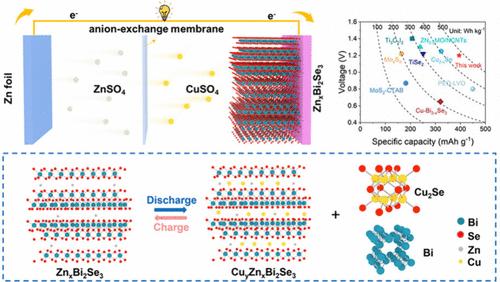阳离子捕获工程定制硒化铋,通过优化的协同双反应机制实现卓越的多价离子存储
IF 9.1
1区 材料科学
Q1 CHEMISTRY, MULTIDISCIPLINARY
引用次数: 0
摘要
水基多价离子电池作为锂离子电池的一种很有前途的替代品,具有成本低、比容量高、安全性强、环境可持续性等优点,已经引起了人们的广泛关注。然而,高效阴极的发展仍然具有挑战性,受到缓慢的多价离子扩散和明显的结构降解的限制。在这里,我们引入阳离子捕获工程来定制拓扑绝缘体Bi2Se3 (ZnxBi2Se3),通过激活额外的活性位点和扩大层间距来提高电化学性能。此外,综合实验表征表明,ZnxBi2Se3通过“协同双反应机制”储存Cu2+,具有快速反应动力学和高容量。因此,获得了优异的倍率性能(1.0 A g-1时350 mAh g-1, 10 A g-1时241.3 mAh g-1)和长循环寿命(10 A g-1时10,000次循环)。此外,制备的准固态柔性袋状电池表现出优越的性能和在各种破坏条件下工作的能力,在柔性电子器件中具有潜在的应用前景。本文章由计算机程序翻译,如有差异,请以英文原文为准。

Cation-Trapping Engineering Tailors Bismuth Selenide to Enable Superior Multivalent Ion Storage via an Optimized Synergistic Dual-Reaction Mechanism
Aqueous multivalent-ion batteries have garnered considerable attention as a promising alternative to lithium-ion batteries, offering advantages such as low cost, high specific capacity, enhanced safety, and environmental sustainability. However, the development of efficient cathodes remains challenging, constrained by sluggish multivalent-ion diffusion and pronounced structural degradation. Here, we introduce cation-trapping engineering to tailor the topological insulator Bi2Se3 (ZnxBi2Se3), enhancing the electrochemical performance by activating additional active sites and expanding the interlayer spacing. Furthermore, comprehensive experimental characterizations reveal that ZnxBi2Se3 stores Cu2+ via a “synergistic dual-reaction mechanism”, attaining rapid reaction kinetics and high capacity. Accordingly, an excellent rate performance (350 mAh g–1 at 1.0 A g–1 and 241.3 mAh g–1 at 10 A g–1) and a long cycling life (10,000 cycles at 10 A g–1) are obtained. Moreover, the prepared quasi-solid-state flexible pouch battery demonstrates superior performance and the ability to operate under various destructive conditions, offering potential utilization in flexible electronic devices.
求助全文
通过发布文献求助,成功后即可免费获取论文全文。
去求助
来源期刊

Nano Letters
工程技术-材料科学:综合
CiteScore
16.80
自引率
2.80%
发文量
1182
审稿时长
1.4 months
期刊介绍:
Nano Letters serves as a dynamic platform for promptly disseminating original results in fundamental, applied, and emerging research across all facets of nanoscience and nanotechnology. A pivotal criterion for inclusion within Nano Letters is the convergence of at least two different areas or disciplines, ensuring a rich interdisciplinary scope. The journal is dedicated to fostering exploration in diverse areas, including:
- Experimental and theoretical findings on physical, chemical, and biological phenomena at the nanoscale
- Synthesis, characterization, and processing of organic, inorganic, polymer, and hybrid nanomaterials through physical, chemical, and biological methodologies
- Modeling and simulation of synthetic, assembly, and interaction processes
- Realization of integrated nanostructures and nano-engineered devices exhibiting advanced performance
- Applications of nanoscale materials in living and environmental systems
Nano Letters is committed to advancing and showcasing groundbreaking research that intersects various domains, fostering innovation and collaboration in the ever-evolving field of nanoscience and nanotechnology.
 求助内容:
求助内容: 应助结果提醒方式:
应助结果提醒方式:


